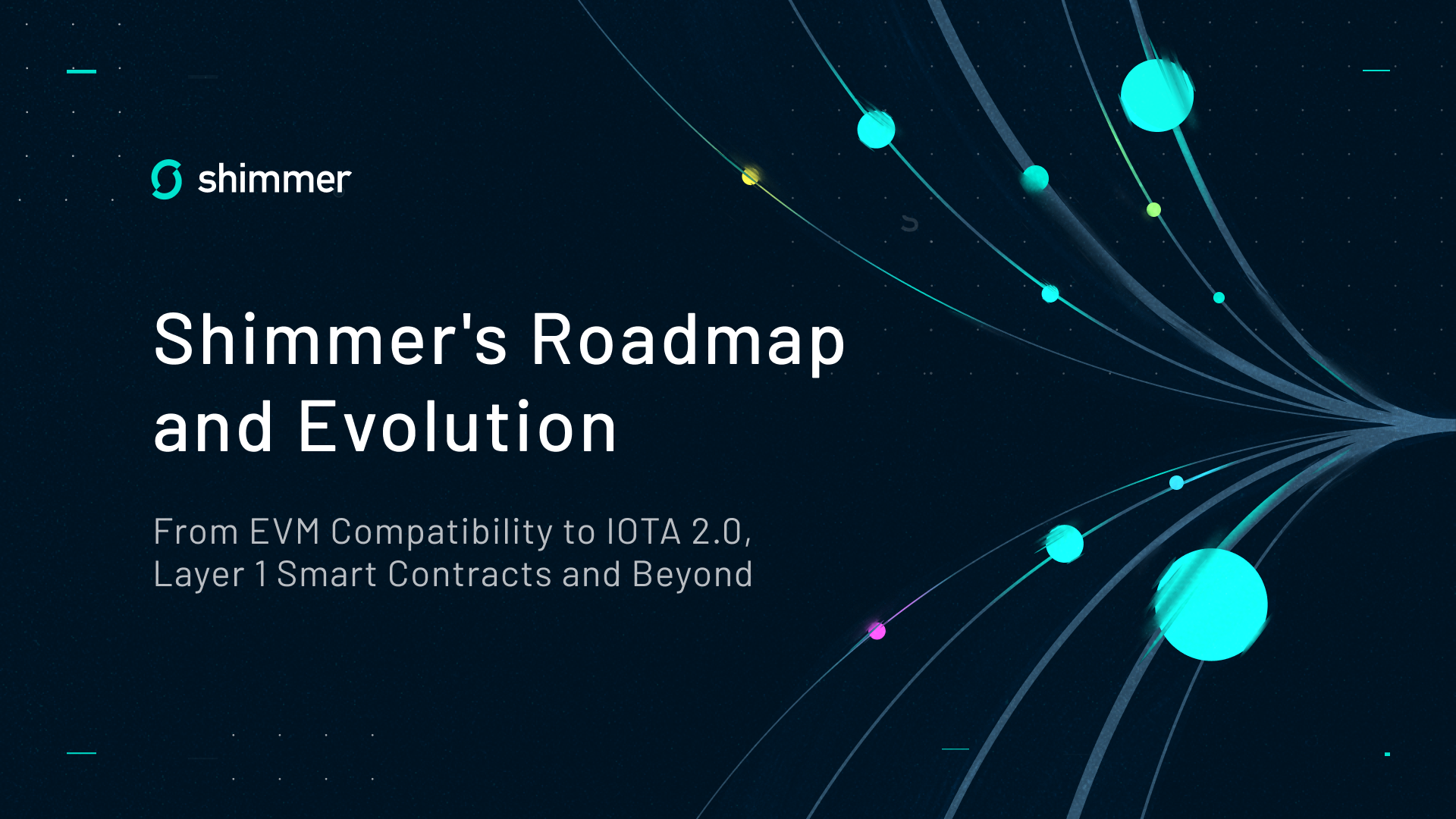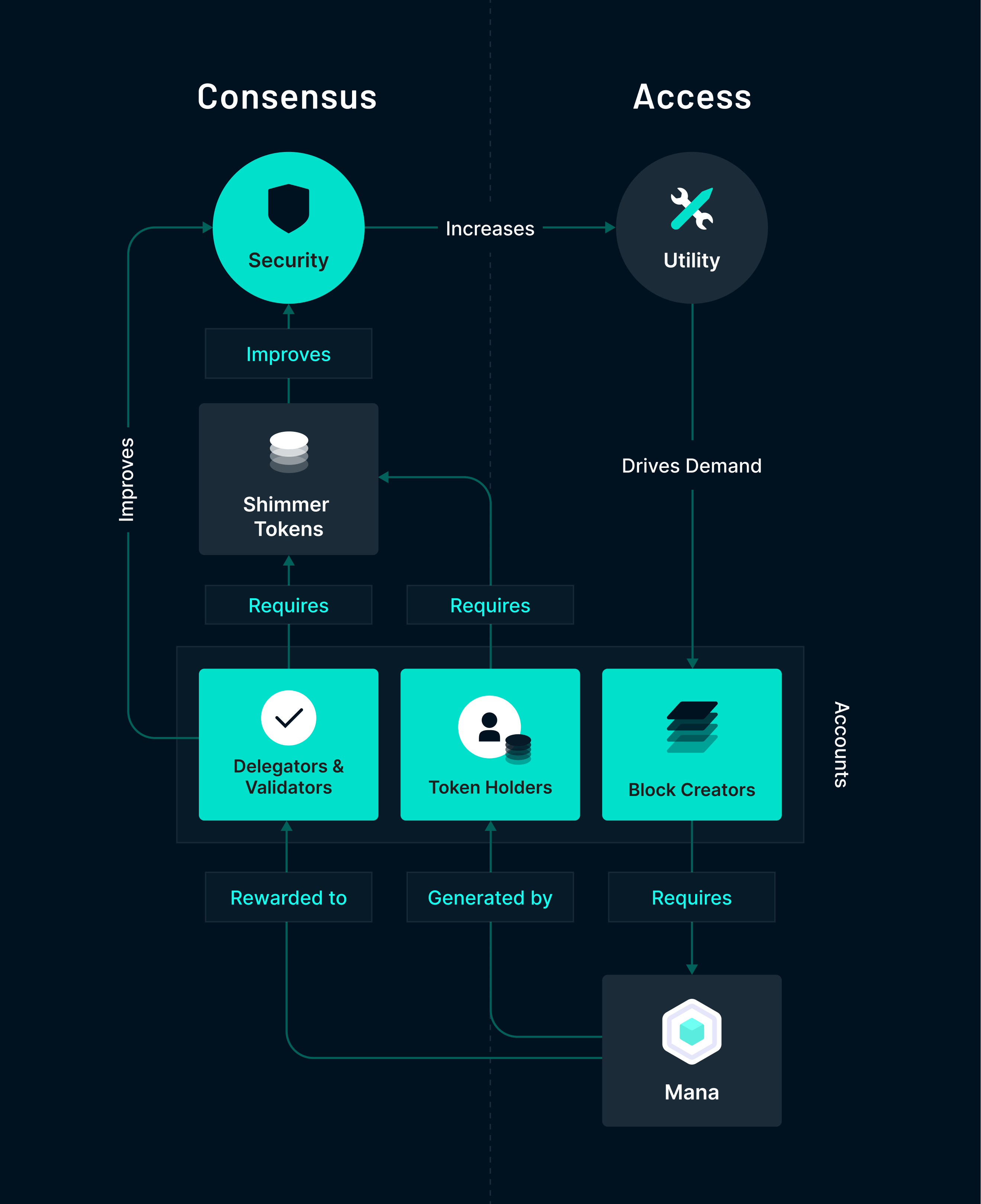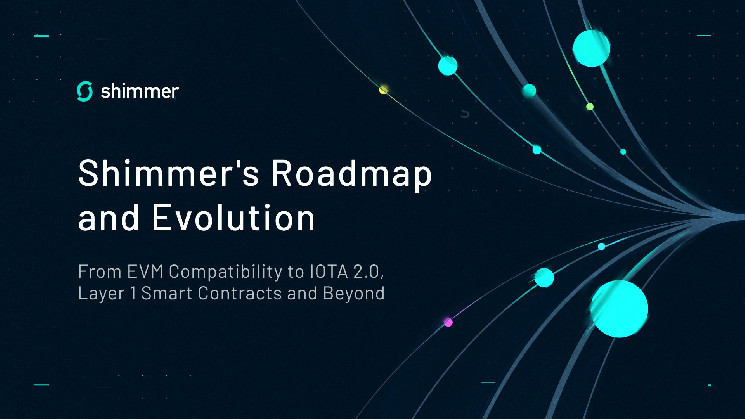From EVM Compatibility to IOTA 2.0, Layer 1 Smart Contracts and Beyond

TL;DR:
Shimmer plays a critical role in advancing the IOTA ecosystem by being the first network where all major protocol upgrades get released, tested, and validated. It serves as a dedicated and independent Layer 1 network to drive IOTA's growth and technological evolution. After the success of the ShimmerEVM and the upcoming release of the IOTA EVM, Shimmer is set to transform with IOTA 2.0, featuring sustainable tokenomics and enhanced programmability, cementing its position in the evolving Web3 landscape.
The Shimmer network plays a pivotal role in validating and accelerating IOTA’s technical roadmap while giving the ecosystem early access to the latest innovations on the protocol and application layers. Over the past 12 months, Shimmer has been essential in helping the IOTA Foundation build out, improve, test, and validate the extension of our Tangle L1 with a robust tokenization framework and EVM smart contract chains on L2. The first dedicated L2 chain – ShimmerEVM – has been successfully running in production for four months and with millions of transactions and TVL.
This forthcoming launch marks a significant milestone in our ecosystem's growth and adoption. It will also bring IOTA and Shimmer to feature parity – at least for a brief moment. While IOTA will build its own EVM ecosystem, the ecosystem that has already been built and is operating on ShimmerEVM will continue to thrive, with dApps providing support and incentives and ShimmerEVM acting as a dedicated staging network for new dApps to deploy.
While Shimmer will continue to support its ecosystem via ShimmerEVM and other L2 chains, Shimmer’s L1 is set to undergo a fundamental transformation with the introduction of IOTA 2.0, sustainable tokenomics with $SMR staking, and programmability on L1. This blog post outlines our roadmap for Shimmer, ensuring its vital role post-IOTA EVM launch.
Our Vision for Shimmer
Shimmer is the official staging network of IOTA, with its own token ($SMR) and real value attached to it. But it’s more than just a testbed where new ideas are nurtured before they mature in the IOTA ecosystem. Shimmer stands as an independent Layer 1 network and dApp ecosystem, boasting a large and loyal community. It opens up new opportunities in DeFi and Web3 for its users. To fully realize its potential, Shimmer will undergo a series of upgrades and releases to enhance its utility and feature set.
Shimmer's Roadmap
Shimmer’s journey is planned in phases, each adding layers of functionality and innovation.
A phased approach is the safest way to deploy cutting-edge technology and rigorously test it with genuine traffic and analytics before integrating it into the IOTA Mainnet.

While the first two phases cover Shimmer’s launch and the introduction of ShimmerEVM, the later stages take place across the next two years.
Phase 1 (Q3 2022): Shimmer Launch – Adding Native Assets to a Parallelized Ledger

Launched in September 2022 with a fair token distribution at a fixed supply and no inflation, Shimmer takes IOTA’s parallelized DAG ledger and adds native assets. Shimmer launched officially with the Stardust protocol, which has since also been introduced on IOTA. Stand-out features making this a truly community network include:
- Parallelized settlement. “Blockchain unchained” with the fast and scalable UTXO-based DAG ledger of Shimmer. Blocks are processed in parallel and don’t have to be ordered into a sequential chain.
- Feeless L1. Any asset transferred on the Shimmer L1 benefits from limitless freedom – including no transaction fees for token holders.
- Native Assets. Shimmer empowers anyone to tokenize and transfer native assets and be in full control over them, without reliance on someone else’s smart contracts.
- NFTs with On-Chain Data. Shimmer enables on-chain data to be immutably attached directly to your NFTs so you never lose track of their valued attributes.
- Custom transaction logic. Shimmer supports the programming of the UTXO ledger with custom output types. Users can implement conditional scripts, like unlock conditions and timelocks, and execute atomic operations, offering flexibility in creating secure and complex transactions.
Phase 2 (Q3 2023): ShimmerEVM Launch – Introducing EVM Compatibility (and Much More)

Launched in September 2023, ShimmerEVM is an EMV-compatible application layer that brings a host of advanced features to the network. This phase equipped Shimmer with the necessary features to build its own Web3 ecosystem. The key features of ShimmerEVM include
- Ethereum Virtual Machine (EVM) Compatibility, which allows developers to run their smart contracts from other EVM chains on Shimmer with minimal or no adjustments.
- Extended EVM Functionality with 'Magic Smart Contracts' that enable users to interact with native assets and NFTs from Layer 1, utilize native randomness, and communicate with other chains anchored to Shimmer by simply calling functions on these pre-deployed contracts.
- L1 Native Asset Support, so users can effortlessly send their SMR tokens (and in the future, NFTs and custom native assets) to the ShimmerEVM through the Firefly wallet, with no need for a special bridge.
- Comprehensive IOTA Smart Contract (ISC) Functionality so anyone can develop and manage smart contracts on the Shimmer network. Refer to the Wiki for more information on everything supported by ISC.
For more on ShimmerEVM and its features, check out the launch blog post here.
Phase 3: Multi-chain expansion – Fostering Interoperability and Scalability

ShimmerEVM is just the first of many chains we foresee being anchored to Shimmer. Thanks to its DAG architecture, Shimmer will support the creation and operation of multiple, individual L2 networks running in parallel, all connected and interoperable within the Shimmer ecosystem via L1. Key characteristics of the multi-chain expansion include:
- Application-Specific Chains: Developers can create chains optimized for particular functionalities, whether for finance, gaming, supply chain management, or any other domain.
- Interoperability and Composability: Seamless connectivity between individual chains so assets and information can easily flow from chain to chain in the Shimmer ecosystem. The Shimmer L1 acts as a trustless bridge between the L2 networks.
- Horizontal Scalability: The network can handle a growing number of transactions and operations by adding more chains, rather than solely relying on scaling up the capacity of a single chain. Countless actors can start up an L2 and communicate with great security and without a centralized bridge.
In short, the multi-chain expansion phase of Shimmer represents its transition into a more diverse, scalable, and interconnected network, capable of supporting a wide variety of applications and use cases.
Phase 4: IOTA 2.0's Leaderless Consensus – Embracing Full Decentralization

Following its trial on a public testnet, the IOTA 2.0 network upgrade will be introduced to the Shimmer L1 this year. This transition marks a move away from the Proof of Authority validator committee to a fully decentralized network – so you’ll be able to experience full decentralization first on Shimmer before it hits the IOTA Mainnet. Alongside decentralization, the IOTA 2,0 protocol delivers massive improvements to Shimmer, including
- Enhanced Reliability and Efficiency: Leaderless consensus doesn’t rely on a single leader but on collaboration by validator nodes. This ensures faster consensus without bottlenecks.
- A more resilient network thanks to Dynamic Network Availability, whichensures the continuous operation of the network even when some validators are offline or the network experiences forks.
- More secure censorship resistance due to a rotating committee of decentralized validators instead of a single block producer.
- More adoption: The shift to a leaderless consensus mechanism is likely to increase the trustworthiness of the Shimmer network in the eyes of users and developers, leading to increased adoption and more diverse applications being built on the network.
The introduction of IOTA 2.0's leaderless consensus on Shimmer will significantly enhance the network's decentralization, scalability, and democratic participation. Find out more about the IOTA 2.0 consensus mechanism here.
Phase 5: $SMR Staking and Sustainable Tokenomics

You’ll first be able to explore the benefits of IOTA 2.0’s sustainable tokenomics on Shimmer, including Mana-based access, decentralized user accounts, and incentivized delegated stake. Mana is a utility asset that powers actions on the network like creating transactions and accessing features like transferring funds, minting an NFT, or engaging with smart contracts.

Following the IOTA 2.0 upgrade, it will be generated simply by holding Shimmer tokens, but more of it can be earned by staking your $SMR and participating in consensus by validating or delegating (read more about IOTA 2.0's tokenomics in this blog post).
Future Phases
Looking into the future of Shimmer's development, we see the integration of smart contracts directly into Shimmer's L1, harnessing its full potential for speed and power and sidestepping the extra work inherent in Layer 2 frameworks. Building on this, we’ll work on developing shared security for Layer 2 solutions, where the robust security of the base layer (L1) is extended to safeguard various L2 chains. This ensures a truly unbeatable, versatile network.
Shimmer and IOTA EVM: A Symbiotic Growth
With a proven track record since its inception in 2023, ShimmerEVM occupies a unique position as a multi-chain solution that allows seamless interaction among EVM-compatible smart contracts, which has already catalyzed a dynamic ecosystem, evident in its over 3.2 million transactions and $13.07m Total Value Locked as of 6 February 2024. The integration with LayerZero and deployment of over 3700 smart contracts demonstrates its robustness and adaptability. As the blockchain landscape continuously evolves, ShimmerEVM’s established infrastructure, thriving community, and ongoing developments assure that it will remain a significant and influential platform.
Shimmer provides a conducive environment for developers to build and refine their technology, projects, and brand, preparing them for future advancements. While large-scale projects and institutional investors are drawn to the prestige and security of the IOTA Mainnet, smaller, innovative Web3 startups find Shimmer appealing.
Additionally, IOTA tokens will be able to be bridged to Shimmer (and vice versa), offering yield and passive income opportunities.
So Shimmer enhances both the utility and reliability of the IOTA Mainnet, with both networks benefitting mutually while keeping highly distinct personalities. Everything we do will reinforce the fact that Shimmer and IOTA EVM aren’t competing entities but complementary forces. While Shimmer serves as the staging ground, testing, and refining innovations, the IOTA EVM leverages these advancements, ensuring robust and tested applications reach the broader ecosystem.
In summary, as the stakes on the IOTA Mainnet increase, Shimmer’s role as a testing and development ground becomes increasingly vital.
 iota-news.com
iota-news.com
